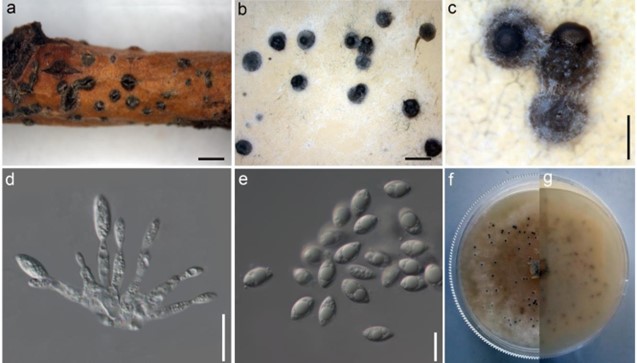Coniella vitis Chethana, J.Y. Yan, X.H. Li & K.D. Hyde, Pl. Dis. 101: 2129 (2017).
MycoBank number: MB 819365; Index Fungorum number: IF 819365; Facesoffungi number: FoF 02722;
Holotype: CHINA, Yanqing, Beijing, on white rot-infected berries of Vitis vinifera (Vitaceae), 13 May 2015, X–H Li, JZB3700001 (MFLU 16-2677), ex-type living culture, MFLUCC 16-1399.
Saprobic or pathogenic on branches and twigs of Prunus armeniaca L. (Rosaceae). Sexual morph: Undetermined. Asexual morph: Coelomycetous. Conidiomata 200–370 μm diam. (x̅ = 304.2 μm , n = 20), pycnidial, solitary, submerged in PDA, globose to slightly depressed globose, with verruculose wall, initially hyaline becoming dark brown to black at maturity, with a central ostiole. Conidiophores 5–9 × 2–4 μm (x̅ = 7.8 × 3.3 μm, n = 10), formed on a dense, cushion-like aggregation of hyaline cells, subcylindrical, hyaline, smooth, simple or branched below, mostly reduced to conidiogenous cells. Conidiogenous cells 9.5–16 × 2.5–4 μm (x̅ = 13.2 × 3.3 μm , n = 10), phialidic, percurrently proliferating, hyaline, simple, slender, smooth with a prominent periclinal thickening. Conidia 8.5–12 9 3.5–6.5 μm (x̅ = 10.2 × 4.9 μm , n = 40), l:w ratio 2, inequilateral, hyaline when immature becoming pale brown, aseptate, straight to slightly curved, narrowly ellipsoidal, often somewhat flattened on one side, both sides gradually tapering towards the subobtusely rounded apex, subtruncate base, smooth-walled, and multi-guttulate with one or two prominent guttules.
Culture characteristics: Colonies on PDA, reaching 8 cm diam. after 5 days at 28 ºC, effuse, flat, mostly immersed mycelium, aerial mycelium mostly sparse, crenulated edges with concentric rings, white on surface and buff in reverse. Conidia in mass, hyaline.
Material examined: RUSSIA, Rostov Region, Shakhty City, on dead twigs (with signs of necrosis) of Prunus armeniaca L. (Rosaceae), 1 March 2016, T.S. Bulgakov, T1243 (MFLU 16-1537), living culture, MFLUCC 18-0093.
GenBank numbers: ITS = MH569466, LSU = MH569461, HIS3 = MH645901, TEF1-a = MH645902.
Known hosts and distribution: Vitis vinifera (China) and Prunus armeniaca (Russia) (Chethana et al. 2017; Farr and Rossman 2018).
Notes: Coniella vitis has been reported from Vitis vinifera as causing grape white rot in China (Chethana et al. 2017; Jayawardena et al. 2018). Based on our phylogenetic analysis of a combined ITS, LSU, HIS3 and TEF1-a sequence dataset of Coniella species (Fig. 82), our strain MFLUCC 18-0093 clusters together with the ex-type strain of Coniella vitis (MFLUCC 16-1399) with high bootstrap and Bayesian probabilities (100% MP and 1.00 BYPP). When comparing our strain with the type specimen of C. vitis (MFLUCC 16-1399), they are similar in morphology. However, our strain has slightly larger conidiomata, and larger conidiogenous cells compared to the type strain (Chethana et al. 2017).

Figure 226 – Coniella vitis (Material examined – RUSSIA, Rostov Region, Shakhty City, on dead and dying branch of Salix alba L. (Salicaceae), 5 March 2016, T.S. Bulgakov, T1278 (MFLU 16– 1572). a Host tissue. b Submerged pycnidia on PDA. c Close view of the pycnidia and the spore mass. d Conidiogenous cells. e Hyaline to brown conidia. f, g Upper view (f) and the reverse view (g) of the colony on the PDA. Scale bars: a, b = 1 mm, c = 500 µm, d = 5 µm, e = 10 µm.
